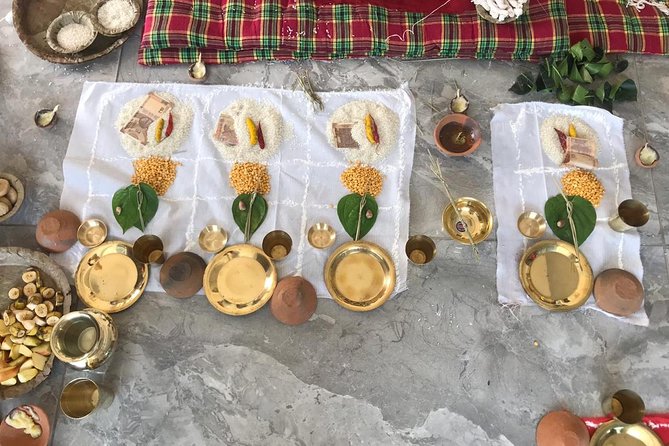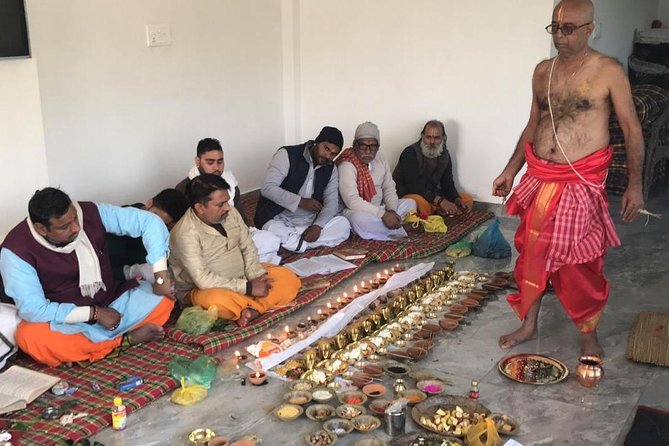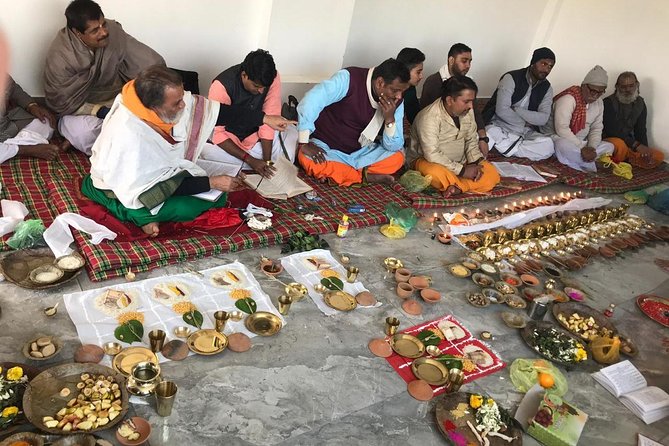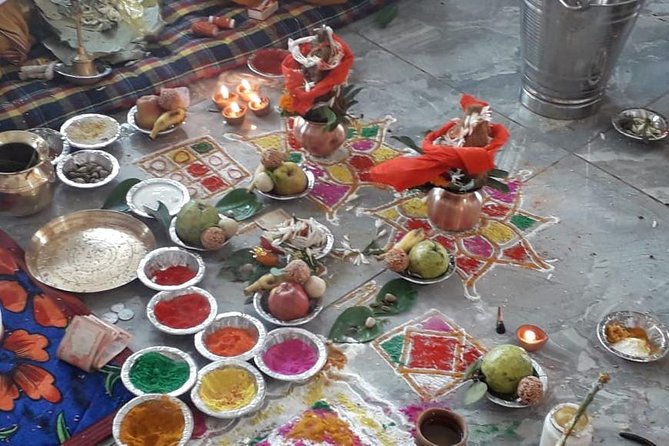In Gaya, the ritual of Pinddaan holds deep significance for many Hindu families seeking to honor their ancestors. This sacred practice, primarily conducted at the Vishnupad Temple and along the Falgu River, involves offering pindas—symbolic rice balls—believed to provide nourishment to departed souls. Families engage in various rituals, including Tarpan and Homa, fostering a connection that spans generations. As participants navigate this profound spiritual landscape, they often wonder about the intricacies of the rituals and the rich cultural heritage surrounding them. What other aspects of this tradition might surprise those unfamiliar with it?
Good To Know

- Pinddaan, a significant Hindu ritual, is performed in Gaya at Vishnupad Temple to honor deceased ancestors and seek their blessings.
- The ceremony involves offering pindas (rice balls) and conducting rituals like Tarpan, Suddhi, Homa, and Shraddha for ancestral peace.
- Gaya offers key spiritual sites, including Vishnupad Temple, Falgu River, Mangla Gauri Shrine, and Mahabodhi Temple, enhancing the Pinddaan experience.
- Accessible transportation and facilities are available, ensuring a comfortable visit for individuals with mobility challenges during the Pinddaan rituals.
- Dining arrangements include vegetarian meals that foster a communal atmosphere, aligning with the sacred nature of the rituals.
Significance of Pinddaan

Pinddaan holds immense significance in Hindu culture, serving as a vital ritual for honoring deceased ancestors. This ceremony, particularly performed in sacred places like Gaya, give you peace and salvation to the departed souls.
By offering pindas—rice balls symbolizing nourishment—family members express their love and gratitude, ensuring their ancestors’ well-being in the afterlife. It’s believed that performing Pinddaan can alleviate ancestral burdens and bring blessings to the family lineage.
Engaging in this ritual strengthens familial bonds, as members come together during this important event. For many, it’s not just a duty but a heartfelt tribute, emphasizing respect for one’s heritage and the importance of remembering those who’ve passed.
It’s an essential practice that connects generations across time.
You can also read our reviews of more tours and experiences in Gaya.
Rituals Overview
During the Pinddaan rituals in Gaya, participants engage in a series of deeply meaningful ceremonies designed to honor their ancestors. These rituals typically involve offerings, prayers, and specific rites that connect individuals with their lineage. Dedicated Purohits guide attendees through each step, ensuring the rituals are performed correctly for maximum spiritual benefit.
Here’s an overview of the key rituals involved:
| Ritual | Description |
|---|---|
| Pinddaan Ceremony | Offering rice balls to ancestors |
| Tarpan | Water offerings to appease spirits |
| Suddhi | Purification rituals |
| Homa | Fire rituals for blessings |
| Shraddha | Special prayers for the deceased |
These rituals not only serve to honor ancestors but also provide comfort and closure to the participants.
Detailed Itinerary

Typically, visitors to Gaya can expect a well-structured itinerary that maximizes their spiritual experience and sightseeing opportunities.
On Day 1, participants begin with the Pinddaan ritual at the revered Vishnupad Temple, dedicating about two hours to this sacred practice. Afterward, they enjoy a restful stay at Andhra & Telangana Bhawan Gaya for twelve hours. A visit to Mangla Gauri Temple wraps up the day, lasting an hour.
Day 2 starts with a one-hour visit to the Mahabodhi Temple, followed by a two-hour puja and darshan at Mangla Gauri Shakti Peetha. The itinerary concludes with four hours dedicated to exploring local attractions, ensuring a fulfilling journey that balances spirituality with cultural insights.
Key Attractions in Gaya
Gaya is a treasure trove of spiritual and cultural landmarks that draw visitors from all over the world. Among its key attractions, the Vishnupad Temple stands out, revered for its historical significance and stunning architecture.
Nearby, the serene Falgu River offers a peaceful setting for reflection. Visitors often make their way to the Mangla Gauri Shrine, known for its divine energy.
Bodhgaya, just a short distance away, features the iconic Mahabodhi Temple and the sacred Mahabodhi Tree, where Lord Buddha attained enlightenment.
Sita Kund and Janki Temple add to the spiritual tapestry, while Haleshwar Asthan and Ram Churaon invite exploration.
Each site provides a unique glimpse into Gaya’s rich spiritual heritage, making it a must-visit destination.
Transportation Options
Navigating the transportation options in Gaya enhances the overall experience of visiting this spiritual hub. Travelers can choose from various convenient pick-up services or opt to meet directly at the Andhra & Telangana Bhawan Gaya. These arrangements ensure that visitors reach their destinations with ease, allowing them to focus on their Pinddaan rituals.
Plus, the local transportation is designed to accommodate all visitors, including those with mobility challenges. With wheelchair-accessible vehicles and smooth surfaces for strollers, Gaya prioritizes inclusivity.
Whether opting for a guided tour or exploring independently, travelers can enjoy seamless access to key attractions. By understanding these transportation options, visitors can maximize their time and spiritual journey in Gaya.
Accessibility Features

Many visitors appreciate the thoughtful accessibility features available in Gaya, ensuring that everyone can partake in the spiritual experience without barriers.
The transportation options are fully wheelchair accessible, allowing smooth travel to various sacred sites. Plus, the surfaces around popular attractions are designed for easy navigation, accommodating strollers and wheelchairs alike.
This commitment to accessibility extends to key locations like Vishnupad Temple and Mangla Gauri Shrine, where facilities cater to those with mobility challenges.
With these features in place, you can focus on their spiritual journey without worrying about physical obstacles.
Gaya has made significant strides to create a welcoming environment, ensuring that everyone can enjoy the rich cultural and spiritual offerings the city has to provide.
Dining Arrangements
Dining arrangements during the Pinddaan experience in Gaya are thoughtfully planned to enhance the spiritual journey. Participants can look forward to delicious meals that nourish both body and soul.
The itinerary includes two lunches and a dinner, all curated with care to accommodate various dietary preferences. Meals are typically vegetarian, aligning with the sacred nature of the rituals.
Dining often takes place at Andhra & Telangana Bhawan, where the atmosphere fosters a sense of community among participants. This setting allows individuals to share their experiences and connect with others on similar journeys.
Booking Information
Participants eager to embark on the Pinddaan journey in Gaya will find the booking process straightforward and user-friendly. They can secure their spots easily and prepare for a meaningful experience.
Here’s what they need to know:
-
Non-Refundable Policy: Be aware that all bookings are non-refundable, so plan accordingly.
-
Confirmation: Participants receive instant confirmation upon booking, unless it’s within an hour of travel.
-
Meals Included: Enjoy two lunches and dinner as part of the package.
-
Transportation Options: Choose between pickup services or heading directly to the Andhra & Telangana Bhawan Gaya.
Frequently Asked Questions
What Is the Spiritual Significance of Pinddaan Rituals?
The spiritual significance of Pinddaan rituals lies in honoring ancestors. It’s believed that performing these rites helps the deceased attain peace and liberation, fostering a deeper connection between the living and their lineage.
How Long Has Pinddaan Been Practiced in Gaya?
Pinddaan rituals have been practiced for centuries, deeply rooted in Hindu tradition. Communities have engaged in these ceremonies, honoring ancestors and seeking blessings, showcasing a continuous cultural legacy that enriches spiritual lives across generations.
Can I Perform Pinddaan for Deceased Pets?
Yes, one can perform rituals for deceased pets, honoring their memory. Many believe it offers solace and closure. It’s essential to consult a knowledgeable practitioner to ensure the rituals are meaningful and respectful.
Are There Specific Days Recommended for Pinddaan?
Many people believe specific days, like Amavasya or during the Pitru Paksha, are ideal for performing Pinddaan. These times hold spiritual significance, allowing for deeper connections with ancestors and enhanced blessings during the rituals.
What Should I Wear During the Pinddaan Ceremonies?
During pinddaan ceremonies, it’s best to wear comfortable, modest clothing. Traditional attire, like a kurta or saree, is encouraged, but practicality matters. Footwear should be easy to remove, as rituals often require bare feet.
The Sum Up
To sum it up, Pinddaan in Gaya offers a unique opportunity to honor ancestors while connecting with spiritual traditions. The rituals not only provide solace but also strengthen family ties and respect for heritage. With a well-planned itinerary, visitors can explore Gaya’s rich culture and serene landscapes. Whether you’re seeking spiritual fulfillment or simply wish to learn more about these age-old practices, Gaya’s offerings make it a meaningful journey for everyone. Don’t miss out on this profound experience!
